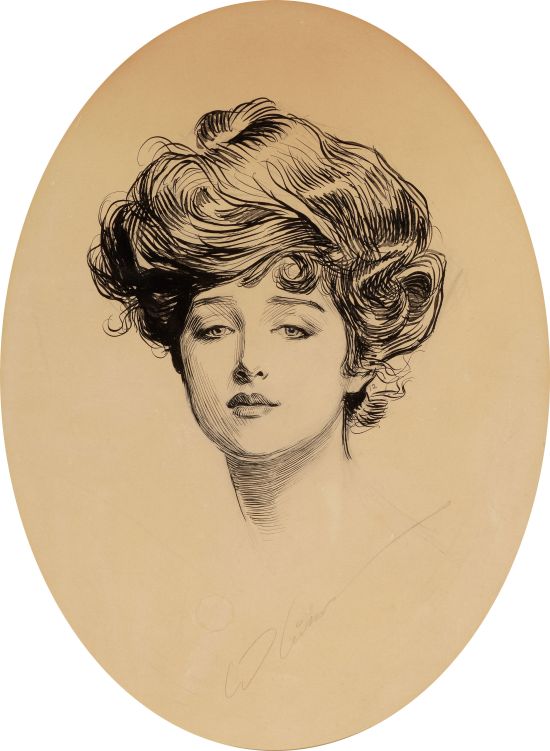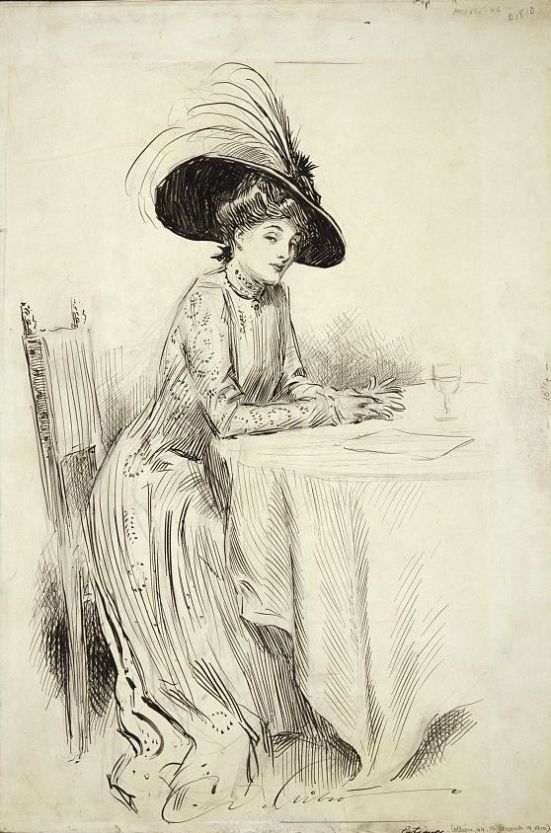
Otto Sarony, Portrait of Evelyn Nesbit, 1901 via

Otto Sarony, Portrait of Evelyn Nesbit, 1901 via

Camille Clifford by Bassano, whole-plate glass negative, 22 May 1916
© National Portrait Gallery, London via
Camille Clifford by Bassano, whole-plate glass negative, 22 May 1916
© National Portrait Gallery, London via
Camille Clifford by Bassano, whole-plate glass negative, 22 May 1916
© National Portrait Gallery, London via
Camille Clifford by Bassano, whole-plate glass negative, 22 May 1916
© National Portrait Gallery, London via
Camilla Antoinette Clifford (1885 – 1971) was a Belgian-born stage actress and the most famous model for the “Gibson Girl” illustrations. Her towering coiffure and hourglass figure defined the Gibson Girl style.
Clifford was born on 29 June 1885 in Antwerp, Belgium to Reynold Clifford and Matilda Ottersen. Camille was raised in Sweden, Norway and Boston. In the early 1900s she won US$2000 in a magazine contest sponsored by illustrator Charles Dana Gibson to find a living version of his Gibson Girl drawings: his ideal woman.Clifford became an actress, performing in the United States from 1902 and in England from 1904. She returned from London to Boston on 3 July 1906.While only playing walk-on, non-speaking roles, Clifford became famous nonetheless: not for her talent, but for her beauty. Her trademark style was a long, elegant gown wrapped around her tightly corseted, eighteen-inch wasp waist.
Photographs of her taken by Lizzie Caswall Smith in 1905 often appear in historical fashion books and on websites to illustrate the Edwardian style.
Camille Clifford via
Camille Clifford via
Camille Clifford via
Camille Clifford via
Camille Clifford via
Camille Clifford via
Evelyn Nesbit (1884 – 1967) was known to millions before her 16th birthday in 1900. She was the most photographed woman of her era, an iconic figure who set the standard for female beauty.
In the early part of the 20th century, her figure and face was everywhere, appearing in mass circulation newspaper and magazine advertisements, on souvenir items and calendars, making her a cultural celebrity. She was a popular cover face on Vanity Fair, Harper’s Bazaar, The Delineator, Women’s Home Companion, Ladies’ Home Journal and Cosmopolitan.
Her career began in her early teens in Philadelphia and continued in New York, where she posed for a cadre of respected artists of the era, James Carroll Beckwith, Frederick S. Church, and notably Charles Dana Gibson, who idealized her as a “Gibson Girl.” She had the distinction of being an early “live model,” in an era when fashion photography as an advertising medium was just beginning its ascendancy.
As a stage performer, and while still a teenager, she attracted the attention of the then 47-year-old architect and New York socialite Stanford White, who became her lover and dedicated benefactor. Nesbit achieved world-wide notoriety when her jealous husband, multi-millionaire Harry Kendall Thaw, shot and murdered Stanford White on the rooftop theatre of Madison Square Garden on the evening of June 25, 1906, leading to what the press would call “The Trial of the Century.” and Evelyn became known as “The Girl in the Red Velvet Swing.”
In 1955 she was portrayed by Joan Collins in the film The Girl in the Red Velvet Swing. Marilyn Monroe had been 20th Century-Fox’s original choice for the role.
Evelyn Nesbit by Rudolf Eickemeyer, Jr. via
Evelyn Nesbit via
Evelyn Nesbit via
Charles Dana Gibson (1867 – 1944) was an American graphic artist, best known for his creation of the Gibson Girl, an iconic representation of the beautiful and independent American woman at the turn of the 20th century.
The artist saw his creation as representing the composite of “thousands of American girls.”The Gibson Girl image combined elements of older American images of caucasian female beauty, such as the “fragile lady” and the “voluptuous woman”. From the “fragile lady” she took the basic slender lines, and a sense of respectability. From the “voluptuous woman” she took a large bust and hips, but was not vulgar or lewd, as previous images of women with large busts and hips had been depicted. From this combination emerged the Gibson Girl, who was tall and slender, yet with ample bosom, hips and buttocks. She had an exaggerated S-curve torso shape achieved by wearing a swan-bill corset. Images of her epitomized the late 19th- and early 20th-century Western preoccupation with youthful features and ephemeral beauty. Her neck was thin and her hair piled high upon her head in the contemporary bouffant, pompadour, and chignon (“waterfall of curls”) fashions. The statuesque, narrow-waisted ideal feminine figure was portrayed as being at ease and stylish.
Many models posed for Gibson Girl-style illustrations, including Gibson’s wife, Irene Langhorne who may have been the original model, and was a sister of Viscountess Nancy (Langhorne) Astor. Other models included Evelyn Nesbit. The most famous Gibson Girl was probably the Belgian-American stage actress, Camille Clifford, whose high coiffure and long, elegant gowns that wrapped around her hourglass figure and tightly corseted wasp waist defined the style

Charles Dana Gibson, The Gibson Girl, Pen and ink on paper, 12.5 x 9.5 in. via

Charles Dana Gibson, A daughter of the south, 1909. Pen and ink, 57 x 40 cm via

Charles Dana Gibson, Well-Dressed Woman, Ink on paper 17 x 12 in. via

Charles Dana Gibson, Sweetest story ever told, 1910. Pen and ink over graphite under drawing ; 57.7 x 43.5 cm via

Charles Dana Gibson pen and ink on paper illustration for Collier’s Weekly; published in the artist’s collection Our Neighbors, 1905 via

Charles Dana Gibson, Patience, 1910 via